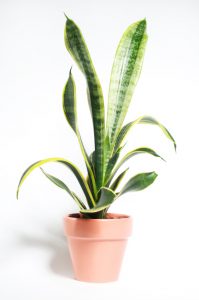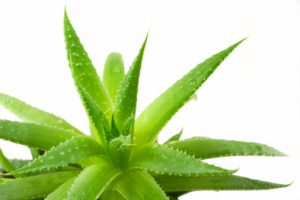by guest blogger Maria Luci, associate editor at Maria’s Farm Country Kitchen
When we think of poor air quality, we often picture smoggy cityscapes and jam-packed highways, but there’s another place where we should be focusing our attention on air pollution: our own homes.
Due to the airtight nature of many houses and apartments today, as well as chemical off-gassing in new constructions (which can last for months), being in your home can be just as dangerous for your health as being in a polluted city. Heard of sick building syndrone, anyone?
With the days cooling and inclement winter weather threatening to trap us indoors again, we’re likely to start feeling the effects of those indoor toxins. Many common indoor pollutants can lead to general illness, increased asthma, allergies, and breathing issues. Luckily, there are a few things you can do to improve the air quality in your home, my favorite being air-purifying houseplants.
In the 1980s, NASA and the Associated Landscape Contractors of America compiled a list of air-filtering plants as a part of their Clean Air Study, which covered potential methods of purifying the air in space stations. The best performers include a list of common houseplants that can be helpful in removing indoor toxins, including heavy hitters like benzene, trichloroethylene, and the highly toxic, yet fairly common, formaldehyde (which can cause eye irritation, headaches, and difficulty breathing at even small concentrations).
So, without further ado, here’s a list of household plants that won’t only brighten your living space, but will help you breathe easier, too:
Snake Plant. I have a snake plant in my own apartment. It’s great because it can live through just about anything; no green thumb necessary! It’s also been shown to filter out benzene, formaldehyde, and trichloroethylene.

Golden Pothos. Prefer hanging plants? Golden Pothos, or devil’s ivy, can make a great addition to your home. It doesn’t even need lots of light. And its green leaves and quick-growing vines will take care of formaldehyde in your space.
Peace Lily. Although not a true Liliaceae family lily, the peace lily can be just as pleasing to the eye. Better yet, it filters the same chemicals a snake plant does while adding xylene, toluene (which even at low levels can cause tiredness and nausea), and ammonia (often found in household cleaners) to its toxin-fighting list.
Bamboo Palm. This fun, tropical plant is great for those with cats that like to nibble. Bamboo palms do well in shady areas and may even produce some flowers and berries for you. They filter out formaldehyde, xylene, and toluene, all while remaining nontoxic to cats. Plus, they can add a bit of “summer” to home, even in the dead of winter.
Gerbera Daisies. I love gerberas! They’re bright, beautiful, and generally make me happy. My wedding was full of orange gerberas. And guess what? They’re also terrific at filtering out pollutants, with benzene at the top of the list.

English Ivy. Golden Pothos not doing it for you? Perhaps this ivy will suit you better. English ivy filters benzene, formaldehyde, xylene, and toluene, and its leaves gorgeously cascade over any pot.

Pleomele. This tropical tree is native to Madagascar and makes for a nice ornamental statement. It also filters out a number of indoor toxins including formaldehyde.
Aloe Vera. Aloe is my favorite of all the toxin-reducing plants! What can I say? I have a soft spot for succulents. Plus, not only does aloe remove pollutants from materials floating around your home, but it also can be used to treat burns and be combined into home remedies and skin products… All while looking pretty!
Added tip: Buy organic houseplants and avoid potting them in plastic.
Here’s to better breathing!
 Maria Luci is the blog and social media manager of Maria’s Farm Country Kitchen. Prior to working at Rodale, she was the publicist and daily blogger for the photography company, Wonderful Machine. She grew up in the woods of Virginia, but now lives in Philly with her husband, a black cat, and a good deal of houseplants.
Maria Luci is the blog and social media manager of Maria’s Farm Country Kitchen. Prior to working at Rodale, she was the publicist and daily blogger for the photography company, Wonderful Machine. She grew up in the woods of Virginia, but now lives in Philly with her husband, a black cat, and a good deal of houseplants.










It always makes me feel better when I read an article like this and find that I have most of these plants already in my apartment. I started collecting Peace Lilies when I read that NASA puts them in with the men traveling through space because it removes formaldehyde from the air. And I have all the others you mention except aloe vera and daisies. I know they help me breathe better. Thanks for this good reminder of how plants help us survive the toxins in our own home.
How nice to learn that my three permanent houseplant pets are such hard workers as well as being easy to care for. The pothos is almost 30 years old and going strong.
Thank you for this information I have a friend who has been diagnosed with a serious illness, but who also lives in a house that was remodeled but they did not move out during its remodeling. I have always believed that part of this illness is due to the uninterrupted habitation of her and her family without any type of solution such as this. I will recommend these plants to her and her family and if you’d like, I’ll keep you posted on her results in the clearing out of what I read in your article that must be truly bombarding her.
TRUE! I love these plants and have them all over the house and outside. Glad that this article is a reinforcement of what otherwise we would not know…..
Hello, just wanted tto mention, I loved this blog post.
It waas practical. Keep on posting!